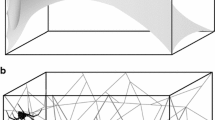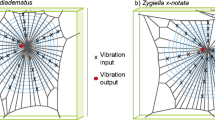Summary
Orbweaving spiders obtain much information from web-borne vibrations. One of their major problems is to distinguish relevant vibrations, particularly prey-produced signals, from irrelevant vibrations, particularly wind noise. This problem was studied by measuring the spectral characteristics of prey-and wind-induced web vibrations, and the spider's responsiveness to sinusoidal stimuli. In wind-generated vibration (Fig. 1) signal amplitude is large below 10 Hz and decreases by 30 to 40 dB/decade above the lowest resonance frequency for each type of web vibration. The lowest resonance for transverse vibration is ∼3 Hz with a 200 mg spider, and ∼10 Hz for longitudinal and lateral vibration. Below ∼10 Hz transverse vibration is much larger than the other two types, but this difference decreases at higher frequencies. Most of the amplitude in prey signals is below ∼50 Hz (Fig. 2), except for buzzing insects such as flies, bees and mosquitoes, whose high wing beats generate significant motion above 100 Hz. The spider's response threshold for sinusoidal stimuli in the prey-catching region of the web (Fig. 3) declines at ∼20 dB/decade over the range that could be measured (10 to 3,200 Hz for longitudinal, 18 to 560 Hz for transverse and 18 to 320 Hz for lateral vibration). The threshold curve for longitudinal vibration is 10 to 20 dB lower than for the other two types and has a minimum of ∼7 μm RMS near 300 Hz. This difference appears to have a mechanical rather than a sensory basis, due to the better transmission of longitudinal vibration through the web (Fig. 4A). If the effect of the spider on web vibration is also considered, the resulting adjusted threshold curve (Fig. 4B: data available for longitudinal vibration only), shows a continuous decline of approximately 30 dB/decade. A possible mechanism for recognizing prey signals based on spectral information is discussed.
Similar content being viewed by others
References
Altes RA (1980) Detection, estimation, and classification with spectrograms. J Acoust Soc Am 67:1232–1246
Barth FG (1982) Spiders and vibratory signals. In: Witt PN, Rovner JS (eds) Spider communication: Mechanisms and ecological significance. Princeton University Press, Princeton, pp 67–122
Barth FG, Geethabali (1982) Spider vibration receptors: Threshold curves of individual slits in the metatarsal lyriform organ. J Comp Physiol 148:175–185
Bleckmann H (1980) Reaction time and stimulus frequency in prey localization in the surface-feeding fish Aplocheilus lineatus. J Comp Physiol 140:163–172
Brown KM (1981) Foraging ecology and niche partitioning in orb-weaving spiders. Oecologia (Berl) 50:380–385
Burgess JW (1979) Web-signal processing for tolerance and group predation in the social spider Mallos gregalis Simon. Anim Behav 27:157–164
Finck A, Reed CF (1979) Behavioral response to whole-body vibration in the orb-weaver Araneus sericatus Clerck (Araneae: Araneidae). J Arachnol 7:139–147
Graeser K (1973) Die Übertragungseigenschaften des Netzes von Zygiella x-notata (Clerck) für transversale Sinusschwingungen im niederen Frequenzbereich and Frequenzanalyse beutetiererregter Nerzvibrationen. Thesis, Universität Frankfurt
Hergenröder R, Barth FG (1983) The release of attack and escape behavior by vibratory stimuli in a wandering spider (Cupiennius salei Keys.). J Comp Physiol 152:347–358
Hoffmaster DK (1982) Responses of the spider Argiope aurantia to low frequency phasic and continuous vibrations. Anim Behav 30:123–127
Houghton JT (1977) The physics of atmospheres. Cambridge University Press, Cambridge London New York Melbourne
Klärner D, Barth FG (1982) Vibratory signals and prey capture in orb-weaving spiders. J Comp Physiol 148:445–455
Lang HH (1980) Surface wave discrimination between prey and nonprey by the back swimmer Notonecta glauca L. (Hemiptera, Heteroptera). Behav Ecol Sociobiol 6:233–246
Liesenfeld FJ (1956) Untersuchungen am Netz und über den Erschütterungsinn von Zygiella x-notata (Cl) (Araneidae). Z Vergl Physiol 38:563–592
Liesenfeld FJ (1961) Über Leistung und Sitz des Erschütterungsinnes von Netzspinnen. Biol Zentralbl 80:465–475
Masters WM (1984) Vibrations in the orbwebs of Nuctenea sclopetaria (Araneidae). I. Transmission through the web. Behav Ecol Sociobiol 15:207–215
Masters WM, Markl H (1981) Vibration signal transmission in spider orb webs. Science 213:363–365
Masters WM, Markl H, Moffat AJM (1985) Transmission of vibration in a spider's web. In: Shear WA (ed) Spiders: webs, behavior, and evolution. Stanford University Press, Stanford, Calif (in press)
Masters WM, Moffat AJM (1983) A functional explanation of top-bottom asymmetry in vertical orbwebs. Anim Behav 31:1043–1046
Nentwig W (1983) The prey of web-building spiders compared with feeding experiments (Araneidae, Linyphiidae, Pholcidae, Agelenidae) Oecologia (Berl) 56:132–139
Pringle JWS (1976) The muscles and sense organs involved in insect flight. RES Symposium 7:3–47
Sheehy JJ (1978) Optimum detection of signals in non-Gaussian noise. J Acoust Soc Am 63:81–90
Snowdon JC (1968) Vibration and shock in damped mechanical systems. Wiley, New York London Sydney
Sotavolta O (1947) The flight-tone (wing-stroke frequency) of insects. Acta Entomol Fenn 4:1–117
Suter RB (1978) Cyclosa turbinata (Araneae, Araneidae): Prey discrimination via web-borne vibrations. Behav Ecol Sociobiol 3:283–296
Uetz GW, Biere JM (1980) Prey of Micrathena gracilis (Walcknaer) (Araneae: Araneidae) in comparison with artificial webs and other trapping devices. Bull Br Arachnol Soc 5:101–107
Walcott C (1963) The effect of the web on vibration sensitivity in the spider, Achaearanea tepidariorum (Koch). J Exp Biol 40:595–611
Walcott C, Kloot WG van der (1959) The physiology of the spider vibration receptor. J Exp Zool 141:191–244
Author information
Authors and Affiliations
Rights and permissions
About this article
Cite this article
Masters, W.M. Vibrations in the orbwebs of Nuctenea sclopetaria (Araneidae). Behav Ecol Sociobiol 15, 217–223 (1984). https://doi.org/10.1007/BF00292978
Received:
Accepted:
Issue Date:
DOI: https://doi.org/10.1007/BF00292978




